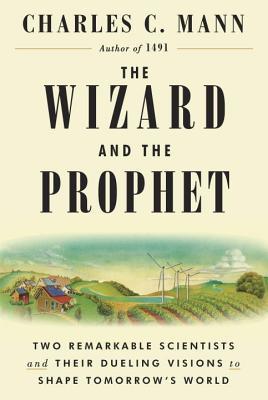The Wizard and the Prophet: Two Remarkable Scientists and Their Dueling Visions to Shape Tomorrow’s World
- By Charles C. Mann
- Knopf
- 640 pp.
- Reviewed by Josh Trapani
- May 15, 2018
Examining the worldviews of two influential but largely forgotten thinkers.

It’s become cliché at institutions of higher learning to point out that large societal problems transcend traditional disciplinary boundaries. If more evidence is needed, consider Charles C. Mann’s The Wizard and the Prophet, which sprawls from history to engineering, from economics to ecology.
The “Wizard” of the title is Norman Borlaug, a Nobel Prize-winning central figure of the Green Revolution and champion of the view that innovation and technology, when applied to environmental problems, “can help us produce our way out of our predicament.”
The “Prophet” is William Vogt, a founder of the modern environmental movement and proponent of “the belief that unless humankind drastically reduces consumption its growing numbers and appetite will overwhelm the planet’s ecosystems.”
Mann describes the lives and times of these two individuals, then uses the contrast between the Wizard’s (“innovate and get more efficient”) and Prophet’s (“scale back consumption”) points of view to investigate the history and possible paths forward on four major global environmental issues: food, fresh water, energy, and climate change.
Inherent in this framing is that scientific solutions to such problems are limited. Environmental policy is not purely technical and must weigh myriad factors, and science is often deployed to support competing solutions. Though Mann doesn’t mention it, in science policy circles, this latter part is termed the “excess of objectivity.” (Maybe someone should notify the organizers of the March for Science.)
While The Wizard and the Prophet generally works, it’s unwise to get hung up on either Vogt and Borlaug themselves — this book is not primarily biography — or the nitty-gritty details of what each stands for. Mann describes the book as a continuum rather than a dichotomy, and he’s right to do so: One need not wade in too deeply before things get murky.
For example, to transition the world’s energy systems to low-carbon sources, Wizards are pro-nuclear, while Prophets favor renewables like solar and wind. Yet when faced with the quandary of the enormous land area required for renewables to fill such a role, “The Prophetic reply is that the technology will improve and become cheaper.”
That sounds like wizardry to me. In some cases, Prophet comes to mean “local” (think: reduce, reuse, recycle) and Wizard “centralized” (think: dams and desalination plants), which is a fine and meaningful distinction, but the path there from Vogt and Borlaug sometimes feels long and winding.
That caveat in mind, the Wizard/Prophet framing remains useful — as heuristic, at minimum — in navigating what might otherwise be a mind-boggling morass. This framing, plus Mann’s deep research and mastery of the subject matter, are gifts to the reader. But the biggest gift is his balance and lack of overt agenda. The author does not consistently come down on one side or the other.
Indeed, beyond arguing for the utility of the Wizard/Prophet framing, he advances few strong conclusions. He writes: “In our internet era, there are entirely too many pundits shouting out advice. I believe I stand on firmer ground when I try to describe what I see around me than when I try to tell people what to do.”
(Indulge a brief digressive opinion: As a reader, I find this problem has become pervasive. Forget nonfiction: I wish more contemporary fiction writers would heed this counsel.)
Let me backtrack: The material covered isn’t always riveting. The reader, despite Mann’s best efforts, must work. “Journalists sometimes describe unsexy subjects as MEGO: My Eyes Glaze Over,” Mann writes. “Alas, water quality is the essence of MEGO.”
Agreed. So are fertilizer, peak oil, C3 versus C4 photosynthesis, and the full-page diagram devoted to wheat breeding. MEGO or not, however, it’s inarguable that “the stakes — human and environmental — are high.”
Population, one of the few subjects on which Mann advances a strong opinion, is where the book falls short. Neither Wizards nor Prophets adequately address handling the estimated 10 billion human beings — nearly 3 billion more than today — projected to inhabit Earth by 2050. Mann reviews the problematic, often racist and coercive history of population control. And, looking at variation in consumption patterns, he claims: “How many people? is an important question, but it is less important than What are those people doing?”
Point taken, but…10 billion? No matter what people are “doing,” they require a minimum amount of resources. All the prophecy and wizardry in the world may not bridge the gap.
Certainly, humanity isn’t making things any easier on itself by continuing to grow by leaps and bounds. This book includes discussion of global geoengineering, construction of 1,000 nuclear plants (in the United States alone), and planting the Sahara with trees to sequester carbon. Given the scope, scale, and cost of such ideas — not to mention risk — even a topic as fraught as controlling population growth shouldn’t be taken off the table.
The overall experience of reading The Wizard and the Prophet is humbling. Humanity faces complex problems and difficult choices. Traditional disciplines and traditional thinking are wholly inadequate to the tasks at hand. If this book is occasionally demanding of readers, just think what we’re demanding from our planet.
Josh Trapani contributes regularly to the Washington Independent Review of Books.

_80_119.png)